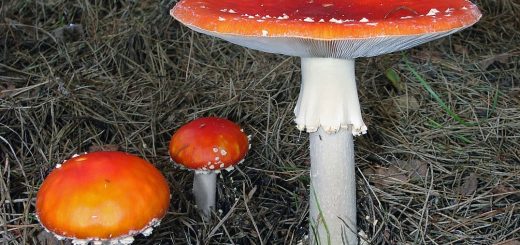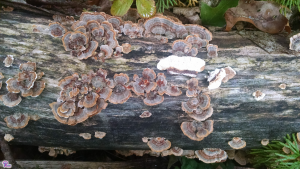#102: The Chicken of the Woods or Sulfur Shelf Fungus
This mushroom is a gateway mushroom to foraging. There is no mistaking the large, bright, yellow-orange fruiting bodies of the Chicken of the Woods. It is also a good edible that has the look, texture, and taste of chicken when cooked (which resulted in one of its common names).
The Chicken of the Woods is parasitic and saprobic on hardwood and conifer trees and causes a brown heart rot. It is often found fruiting near the bases of standing, dead trees or on fallen logs. You can find the Chicken of the Woods fruiting in the summer and fall, although it can occasionally be found as early as morel season. It is a shelf fungus, so it forms individual fruiting bodies that are fan-shaped or bracket-shaped. The individual mushrooms are usually arranged large in clusters of overlapping brackets on the side of a log or in rosettes on the top of a log. The individual brackets can get up to 30cm across, 20cm deep, and 3cm thick. Each one is bright orange to yellow (fading with age) on top, with variations of color and texture arranged in concentric bands. They are usually smooth and somewhat velvety, but often have irregular bulges and wrinkles. Underneath, the brackets sport tiny pores (3-4 per millimeter) that are white, yellow, or salmon-colored. The flesh of Chicken of the Woods is white to yellowish, thick, soft, and watery when fresh. In age, it becomes tough and inedible.
The Chicken of the Woods is a good edible (for most people, see below for discussions of edibility based on region), but will cause gastrointestinal upset when uncooked. Edible mushrooms should always be cooked thoroughly. Fortunately, you don’t need to worry about look-alikes with North American Chicken of the Woods, so this is a great mushroom for novice foragers! There was one person who mistook Chicken of the Woods for Golden Chanterelles, but I really don’t know how that happened. Older parts of the mushroom turn tough (and often contain numerous bugs), so only the actively-growing edges should be eaten. Fortunately, the clusters often get very big, so you can easily make a meal out of a single cluster. The Chicken of the Woods works very well as a substitute for chicken in many dishes!
There are actually five species and one variety in North America that share the common names Chicken of the Woods and Sulfur Shelf Fungus: Laetiporus sulphureus, L. cincinnatus, L. gilbertsonii, L. gilbertsonii var. pallidus, L. conifericola, and L. huroniensis. These species all look very similar, but can easily be separated on the basis of pore color, location, and host tree.
L. sulphureus and L. cincinnatus occur east of the Great Plains and can be found on hardwoods. The former has a bright yellow pore surface, which distinguishes it from the white pore surface of the latter. L. cincinnatus also tends to form rosettes on the ground near its host tree, which is unusual among North American Laetiporus species. According to Tom Volk, L. cincinnatus tastes better and its entire fruiting body can be eaten. There are reports of gastrointestinal upset with some Chicken of the Woods species, but these two apparently never cause problems when cooked properly.
The West Cost plays host to L. gilbertsonii and L. conifericola. If you found your Chicken of the Woods on oak or eucalyptus trees in the region, then it is L. gilbertsonii. If your specimen was growing on conifers, then it is L. conifericola. L. gilbertsonii and L. conifericola are known to cause gastrointestinal upset on occasion (though less frequently in the latter). This may be caused by improper cooking, collection of old specimens, or its growth on eucalyptus. Most people who eat these species do not have problems, so I would probably describe these species as “edible for most.” Many people, however, simply decide to avoid West Coast Chicken of the Woods. If you do decide to eat it, make sure to cook it thoroughly, use only the actively growing edges, and eat only small quantities at a time. As with any new mushroom, only try a little bit the first time. If you experience any GI irritation after eating one of them, I would suggest avoiding the species in the future.
L. gilbertsonii var. pallidus can be found in the Southern United States along the Gulf Coast. Like the California version, this mushroom grows on oak and eucalyptus trees. However, the Gulf Coast variety has a white pore surface, which resulted in its variety name “pallidus.” This mushroom likely causes poisonings with the same frequency as L. gilbertsonii. Follow the advice I gave for that mushroom, above.
The final Chicken of the Woods species, L. huroniensis, is found only in the Great Lakes region (as suggested by its species name). It has a yellow pore surface and fruits from conifers, which separates it from the other two Eastern North American species. L. huroniensis is reported to cause some poisonings, so you may want to avoid this species. There are two other Chicken of the Woods species in the area that can be eaten without problems, and they will likely be fruiting at the same time. Of course, poisonings from L. huroniensis are still rare, so you can decide to eat it, but follow my advice for eating the West Cost species.
There is one further Laetiporus species in North America: L. persicinus. This species is characterized by brown pigments, so it is rarely called a Sulfur Shelf or Chicken of the Woods. Indeed, genetic analysis suggests that it may belong to a different genus altogether. Its fruiting habit and morphology do resemble the other Laetiporus species. However, its pileus is light tan to brown and its pore surface is creamy tan to pinkish tan. L. percsicinus is not found as often as the other species of Laetiporus, so there does not seem to be consensus about whether or not the mushroom is edible.
This post does not contain enough information to positively identify any mushroom. When collecting for the table, always use a local field guide to identify your mushrooms down to species. If you need a quality, free field guide to North American mushrooms, I recommend Michael Kuo’s MushroomExpert.com. Remember: when in doubt, throw it out!
See Further:
http://www.mushroomexpert.com/laetiporus_sulphureus.html
https://blog.mycology.cornell.edu/2006/10/31/eating-the-chicken-of-the-woods/ (Includes recipe!)
http://botit.botany.wisc.edu/toms_fungi/jul2001.html
http://www.fpl.fs.fed.us/documnts/pdf2001/burds01a.pdf
http://www.mykoweb.com/CAF/species/Laetiporus_gilbertsonii.html
http://www.mykoweb.com/TFWNA/P-52.html
http://blog.crazyaboutmushrooms.com/chicken-woods-mushrooms-primer-laetiporus/








![#011: Characteristics of Kingdom Fungi [Archived]](https://www.fungusfactfriday.com/wp-content/themes/hueman/assets/front/img/thumb-small-empty.png)


4 Responses
[…] this post. Laetiporus persicinus does not resemble Chicken of the Woods (L. sulphureus and allies, FFF#102), despite the fact that they belong to the same genus. Instead, it is closer in appearance to […]
[…] fomentarius. In the warmer seasons you can also find many fleshy polypores. These include the Chicken of the Woods (Laetiporus sulphureus), one of the easiest edible mushrooms to find and identify. Most polypores […]
[…] once heard of someone who mistook O. illudens for Chicken of the Woods (Laetiporus sulphureus, FFF#102). Chicken of the Woods has bright yellow pores underneath its orange pileus, is attached wood […]
[…] and grows on conifers, making it easy to distinguish. Chicken of the Woods (Laetiporus spp., FFF#102) is another common polypore with an orange-yellow cap, but it does not stain when handled and has a […]